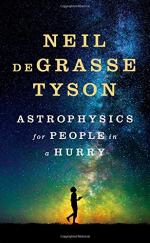|
This section contains 959 words (approx. 3 pages at 400 words per page) |

|
Summary
After the big bang, for some 380,000 years, the universe was “simply a glowing opaque fog,” as rapidly moving electrons scattered photons, or light energy, in every direction (49). As the universe cooled and expanded, these particles began to move more slowly; when the temperature dipped below 3,000 degrees Kelvin, “electrons slowed down just enough to be captured by passing protons,” which created atoms and allowed for “previously harassed” photons to be released in the form of visible light (49). Named the “cosmic background” or “cosmic microwave background,” the measurement of electromagnetic waves can be used to map the formation of the universe, as it is essentially the “leftover light” from the big bang (49, 50).
The existence of the cosmic microwave background was first hypothesized in the 1940s by American physicists Ralph Alpher and Robert Herman. The duo predicted not only its existence, but also its...
(read more from the Let There Be Light Summary)
|
This section contains 959 words (approx. 3 pages at 400 words per page) |

|




